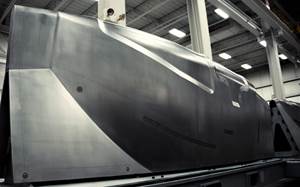Boat builder Lyman-Morse creates aerospace composite prototype
Prototypes for such clients as the Department of Defense and other government and private sector businesses has become an increasingly important segment of the the company’s business plan.
Lyman-Morse Technologies (LMT, Thomaston, ME, US), a division of Lyman-Morse, has recently manufactured a composite aerospace component for a manufacturer of advanced jet aircraft. The component manufactured is a prototype Radome, a thin fiberglass dome that protects and provides aerodynamic fairing over the aircraft’s primary radar usually located in the nose of the aircraft. The LMT Radome was manufactured to extremely rigorous manufacturing standards and tolerances. LMT designed and manufactured the pattern, mold tooling, and fixtures all in-house with existing staff and equipment.
Prototypes for such clients as the Department of Defense and other government and private sector businesses has become an increasingly important segment of the the company’s business plan. Lyman-Morse Boatbuilding is a custom and semi-custom builder of and service provider for sailing and motor yachts. A family run, father and son business, Lyman-Morse specializes in composites, advanced composites and aluminum construction.
Here are the details on the aerospace prototype:
The pattern for the composite mold was machined by Lyman-Morse’s Haas GR 712 precision CNC router. The pattern was machined from stacked and bonded epoxy tooling board which is geometrically stable at the curing temperature of the fiberglass epoxy pre-preg system. The pattern was designed to compensate for thermal growth of the epoxy board as well as the cross link shrinkage of the tooling system. The Haas GR 712 router machined the pattern with minimal offset to compensate for hand finishing. When all was said and done, the pattern was measured to within .001” of the design target, a challenging task for a 19” diameter article.
Cytec’s LTM-16 fiberglass tooling system was selected to fabricate the all composite mold tool. LTM-16 was selected for its low initial cure temperature of 140°F and its ability to remain dimensionally stable at the 280°F (the processing temperature of Park Electro-Chemical’s E-765 7781 fiberglass prepreg system).
E-765 7781 fiberglass prepreg is qualified under AGATE Aerospace Material Qualification Standards for both primary and secondary flight structure components via the FAA. The fiberglass prepreg was laid up in the mold tool utilizing ply patterns and overlaps developed by LMT and approved by the customer. LMT’s laser placement guide was used to ensure all 40 individual plies were placed in exact sequence and position. Environment conditions were monitored and tracked electronically to ensure both temperature and humidity were within prescribed guidelines.
The layup was then cured for 14 hours per the prepreg manufacturer’s recommendations. During that time, four locations on the part and mold tool were tracked and electronically recorded along with the vacuum within the vacuum bag with LMT custom-built temperature/vacuum data recorder. This step was necessary to ensure processing parameters were meet for the AGATE qualified fiberglass prepreg.
The cured part was machined and drilled to the customer’s specifications, with tolerances of +.005”/-.000”. Final quality checks were completed and found within the customer’s requirements. The part was then painted using Aerospace Certified Paints and Primers. The client will use the prototype as a basis for design and manufacturing refinements.
“We have the know-how and experience with the materials, the manufacturing procedures, the brainpower to trouble shoot and problem solve with these companies. A truly satisfying endeavor for all involved,” said Drew Lyman, president of Lyman-Morse.
Related Content
Nine factors to consider when designing composites cure tooling
Gary Bond discusses the common pitfalls and compromises when designing good cure tooling and their holistic significance for a robust composite production process.
Read MoreDigitizing tools for composites production
Alpex Technologies focuses on industrialization, process and part intelligence and biocomposites in its next generation of tooling systems.
Read MoreComposites enable epic interior for Museum of the Future
For this one-of-a-kind lobby, AFI pioneered digital, reconfigurable molds to achieve organic-shaped, multifunctional panels and stairwell cladding.
Read MoreMetal AM advances in composite tooling, Part 1
Multiple metal additive technologies are gaining market acceptance and interest for composite tooling used in processes ranging from short-fiber injection to autoclave-cure prepreg.
Read MoreRead Next
CW’s 2024 Top Shops survey offers new approach to benchmarking
Respondents that complete the survey by April 30, 2024, have the chance to be recognized as an honoree.
Read MoreComposites end markets: Energy (2024)
Composites are used widely in oil/gas, wind and other renewable energy applications. Despite market challenges, growth potential and innovation for composites continue.
Read MoreFrom the CW Archives: The tale of the thermoplastic cryotank
In 2006, guest columnist Bob Hartunian related the story of his efforts two decades prior, while at McDonnell Douglas, to develop a thermoplastic composite crytank for hydrogen storage. He learned a lot of lessons.
Read More
















.jpg;maxWidth=300;quality=90)








